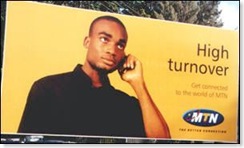South African mobile telecoms provider MTN Group today reported interim results for the six months to end-June, recording a 53 per cent growth in subscribers year-on-year to 74.1 million, and revenues of R46.1 billion (US$5.99 billion), up 35 per cent year-on-year. 
MTN is Africa’s pre-eminent mobile telecoms provider, but has failed to ratify deals with Indian investors in recent months.
EBITDA for the six months to end-June amounted to R19.6 billion, up 29 per cent year-on-year, with the group taxation charge increasing by R2.4 billion compared to the six months ended June 2007. MTN explained this relates mainly to the ending of pioneer status tax holiday in Nigeria in March 2007 resulting in a tax charge of R2.9 billion for the period under review as compared to R1.0 billion for the period ended June 2007.
MTN’s network spans 21 markets across Africa, the Middle East and the Mediterranean, and performance in its three largest markets was robust The number of MTN South Africa subscribers increased by five per cent to 15.6 million in June 2008 from 14.8 million in December 2007. This was mainly due to strong growth in prepaid subscribers, which grew by six per cent to 13 million and to a lesser extent the four per cent growth in postpaid subscribers to 2.6 million.
Average revenue per user (ARPU) of the prepaid segment remained stable at R92 while postpaid ARPU increased by R9 to R405. The prepaid ARPU performance was positively influenced by the continued success of the low denomination vouchers. Blended ARPU, as a consequence of the movement in postpaid ARPU and increased contribution of prepaid subscribers, showed a decline by R4 to R145 from December 2007.
MTN reported that during the six months additional nodes were introduced to increase capacity on the voice and data core networks of 25 per cent and 30 per cent respectively. SMS capacity was also increased by over 40 per cent.
MTN’s subscriber base in Nigeria increased 12 per cent to 18.6 million subscribers from December 2007. ARPU declined slightly to US$16 from US$17 reported at the end of last year. The operator believes the trend is in line with the increasing competitive environment and the deeper mobile penetration into the market, which is now at 31 per cent. Market share marginally declined to 43 per cent from 44 per cent in December 2007.
Aggressive network roll out continued during the first half of the year and 758 new BTS sites were integrated into the network, with MTN reporting that 494 3G sites are now live. Over1,200 kms of new microwave backbone routes are already in progress and shall be completed by the end of 2008.
In Iran, MTN’s subscriber base grew 93 per cent from December 2007 to 11.6 million users. The aggressive subscriber acquisition rate can mainly be attributed to the ‘buy one get one free’ campaigns, competitive SIM pricing, which lowered upfront cost of ownership, and attractive basic and promotional tariff plans. Market share increased from 23 per cent in December 2007 to 32 per cent at the end of June 2008, while mobile penetration moved up from 37 per cent to 50 per cent over the same period.
Iran’s ARPU declined marginally from US$10 in December 2007 to US$9 for this half-year period as the operation continued to attract low income subscribers, MTN reported.
During the half-year period, 696 new BTS sites were rolled out bringing the total live sites to 2,649. At the end of June 2008, 454 cities had been covered by the network, of which 220 were switched on this year, and a total of 4,027 kms of road coverage has been put on the ground (2,918 kms at December 2007). Population coverage has increased from 50 per cent in December 2007 to 57 per cent in June 2008.
MTN Iran now has seven established dealers of its products with 6,000 registered dealer outlets and 40,000 points of sale countrywide.






